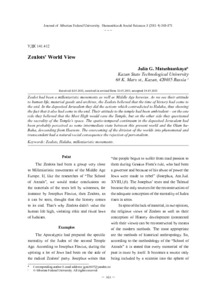Мировоззрение зелотов
Скачать файл:
URI (для ссылок/цитирований):
https://elib.sfu-kras.ru/handle/2311/2262Автор:
Матушанская, Ю.Г.
Matushanskaya, Julia G.
Дата:
2011-03Аннотация:
Зелоты были милленаристским движением, подобным средневековым ересям. Судя по их
отношению к человеческим жизням, материальным ценностям и архивам, зелоты считали,
что время истории кончилось. В осажденном Иерусалиме они предпринимали действия,
явно противоречащие Галахе, тем самым, показывая, что время ее действия истекло. Их
отношение к Храму было амбивалентным, с одной стороны, они считали, что Всевышний
сохранит Храм, а с другой стороны - сакральность пространства Иерусалимского Храма
зелоты оспаривали. Пространственно- временной континуум в осажденном Иерусалиме, по-
видимому, воспринимался как промежуточное состояние между этим миром и спускающимся
свыше Олам Хаба. Это преодоление разделения миров на феноменальный и трансцендентный
имело своим естественным социальным следствием отрицание персонализма. Zealot had been a milleniaristic movements as well as Middle Age heresies. As we see their attitude
to human life, material goods and archives, the Zealots believed that the time of history had come to
the end. In the deposited Jerusalem they did the actions which contradicted to Halaha, thus showing
the fact that it also had come to the end. Their attitude to the temple had been ambivalent - on the one
side they believed that the Most High would save the Temple, but on the other side they questioned
the sacrality of the Temples space. The spatio-temporal continuum in the deposited Jerusalem had
been probably perceived as some intermediate state between this present world and the Olam ha-
Baha, descending from Heavens. The overcoming of the division of the worlds into phenomenal and
transcendent had a natural social consequence the rejection of personalism.

